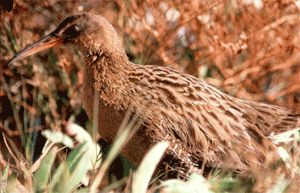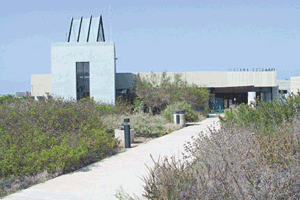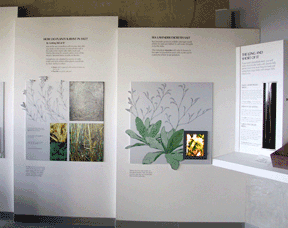 In
1977, developers were planning an elaborate
residential marina in the Tijuana River estuary
in Imperial Beach, California. To protect this
critical habitat, local environmental activists
initiated a grassroots movement to stop the
marina development. In 1979 this group formed
the Southwest Wetlands Interpretive Association
(SWIA), a non-profit 501(c)3. Working cooperatively
with the U.S. Navy and the U.S. Fish & Wildlife
Service (USFWS), the marina development was
blocked and the estuary spared. In 1980 the
505-acre Tijuana Slough National Wildlife Refuge
was created to permanently protect endangered
and threatened species that depend on the estuary
and salt-marsh habitat. In 1982 the National
Oceanic and Atmospheric Administration (NOAA)
extended federal protection with the creation
of the 2800-acre Tijuana River National Estuarine
Sanctuary. The Sanctuary, now known as the Tijuana
River National Estuarine Research Reserve (TRNERR),
contains the Refuge and other public and private
land. In
1977, developers were planning an elaborate
residential marina in the Tijuana River estuary
in Imperial Beach, California. To protect this
critical habitat, local environmental activists
initiated a grassroots movement to stop the
marina development. In 1979 this group formed
the Southwest Wetlands Interpretive Association
(SWIA), a non-profit 501(c)3. Working cooperatively
with the U.S. Navy and the U.S. Fish & Wildlife
Service (USFWS), the marina development was
blocked and the estuary spared. In 1980 the
505-acre Tijuana Slough National Wildlife Refuge
was created to permanently protect endangered
and threatened species that depend on the estuary
and salt-marsh habitat. In 1982 the National
Oceanic and Atmospheric Administration (NOAA)
extended federal protection with the creation
of the 2800-acre Tijuana River National Estuarine
Sanctuary. The Sanctuary, now known as the Tijuana
River National Estuarine Research Reserve (TRNERR),
contains the Refuge and other public and private
land.
 In
1990 SWIA, together with California State Parks
(CSP), USFWS and NOAA, constructed the award-winning,
$1.2 million Tijuana Estuary Visitor Center
at the northern end of the Tijuana River National
Estuarine Research Reserve (TRNERR). In 1992
SWIA was project manager for Ecoparque, an innovative,
low tech wastewater recycling project in Mexico.
This binational project addressed sewage overflow
issues at the border and was funded through
the State Coastal Conservancy. In
1990 SWIA, together with California State Parks
(CSP), USFWS and NOAA, constructed the award-winning,
$1.2 million Tijuana Estuary Visitor Center
at the northern end of the Tijuana River National
Estuarine Research Reserve (TRNERR). In 1992
SWIA was project manager for Ecoparque, an innovative,
low tech wastewater recycling project in Mexico.
This binational project addressed sewage overflow
issues at the border and was funded through
the State Coastal Conservancy.
Over the years SWIA has managed cutting edge
wetlands restoration projects throughout the
Tijuana River Valley. In 1992 the Tijuana NERR
Management Authority adopted the Tijuana Estuary
Tidal Restoration Program (TETRP) that calls
for the restoration of 520 acres of inter-tidal
wetlands. TETRP is one of the largest wetlands
restoration projects in the nation. In 1997
SWIA managed the first phase of this plan, the
Oneonta Tidal Linkage project, which enhanced
circulation and increased tidal flushing in
200 acres of intertidal salt marsh. In 1999
SWIA managed the next phase of TETRP, the Model
Marsh Project. Through excavation, re-vegetation
and natural species colonization this project
created a twenty acre intertidal marsh plain
with both mudflat and vegetated areas. SWIA
is currently the project manager for TETRP II,
which is in the process of developing a restoration
plan based on Model Marsh research findings
for the remainder of the target wetlands. SWIA
is currently partnering with the State Coastal
Conservancy and United States Fish & Wildlife
Service to develop a program to eradicate and
control invasive non-native plants in both public
and private lands in the Tijuana River Valley.

|